
The proliferation of rats, along with steady pressure from mice, squirrels, moles, chipmunks, gophers and other rodents, bodes well for business. Two in three PMPs (66 percent) said they expect to see an increase in the percentage of revenue generated by rodent work, and more than half (51 percent) said that rodent work has become more significant to their business over the past five years.
The residential market generates the most rodent income for about three-fourths (74 percent) of pest management companies; the commercial market accounts for the highest income among the other one-fourth (25 percent).
“Right now, more than half of our revenues come from rodent services, and we expect to see that percentage continue to rise,” says Tristen Rush of Tailored Pest Solutions in Pelham, Ala. “A lot of people are still working from home and spending most of their time at home, so they’re very tuned in to the signs that they may have infestations of squirrels, roof rats, mice or other animals.”
Like the majority (60 percent) of PCT survey respondents, Rush structures his rodent contracts to fit the particular circumstances of an account. “If it’s mice, then I just incorporate the service into the general pest contract. If it’s rats or something bigger, then I set the customer up with a stand-alone contract that includes two to four weeks of dedicated trapping. If they won’t let me do the exclusion work, then we’re looking at a longer-term contract that includes rodenticide in addition to trapping,” he explains.
When he does do the exclusion work, Rush provides a one-year warranty. “I set customers’ expectations so they understand that it’s not realistic to believe they will never see another rodent. No matter how well we exclude, rodents will work night and day to find or create a new way in. So we do our best job to seal the structure, and if an issue comes up for the customer, then we are always here to work through that with them,” he says.
That high level of commitment keeps rodent exclusion work rolling in for Rush, not only because customers talk to their neighbors but because other local pest management businesses have taken note. “Our business is 100 percent referral-based, with most of our leads coming from companies that don’t do exclusion work,” explains Rush. “I don’t poach their general pest work; I just do the exclusion work and build rapport with the customer to not only let them know they can rely on us, but also solidify their confidence in the general pest firm that sent us there.”


Explore the December 2022 Issue
Check out more from this issue and find your next story to read.
Latest from Pest Control Technology
- NYC PCO Growing Business with Focus on Corporate Clients
- Massey Services Promotes Silver, Crespo to Director Roles
- Recurring Services Model, Wildlife Offerings Lead to Impressive Growth for Tailor Made
- Shelters: Difficult to Manage
- NPMA Announces Recipients of 2025 Impact Awards
- Fleetio Expands Geotab Integration with Shop Network Add-In
- RISE Hosts Breakfast at AMCA for Pesticide Advocacy
- WPCA Hosts Annual Midwest Pest Con





